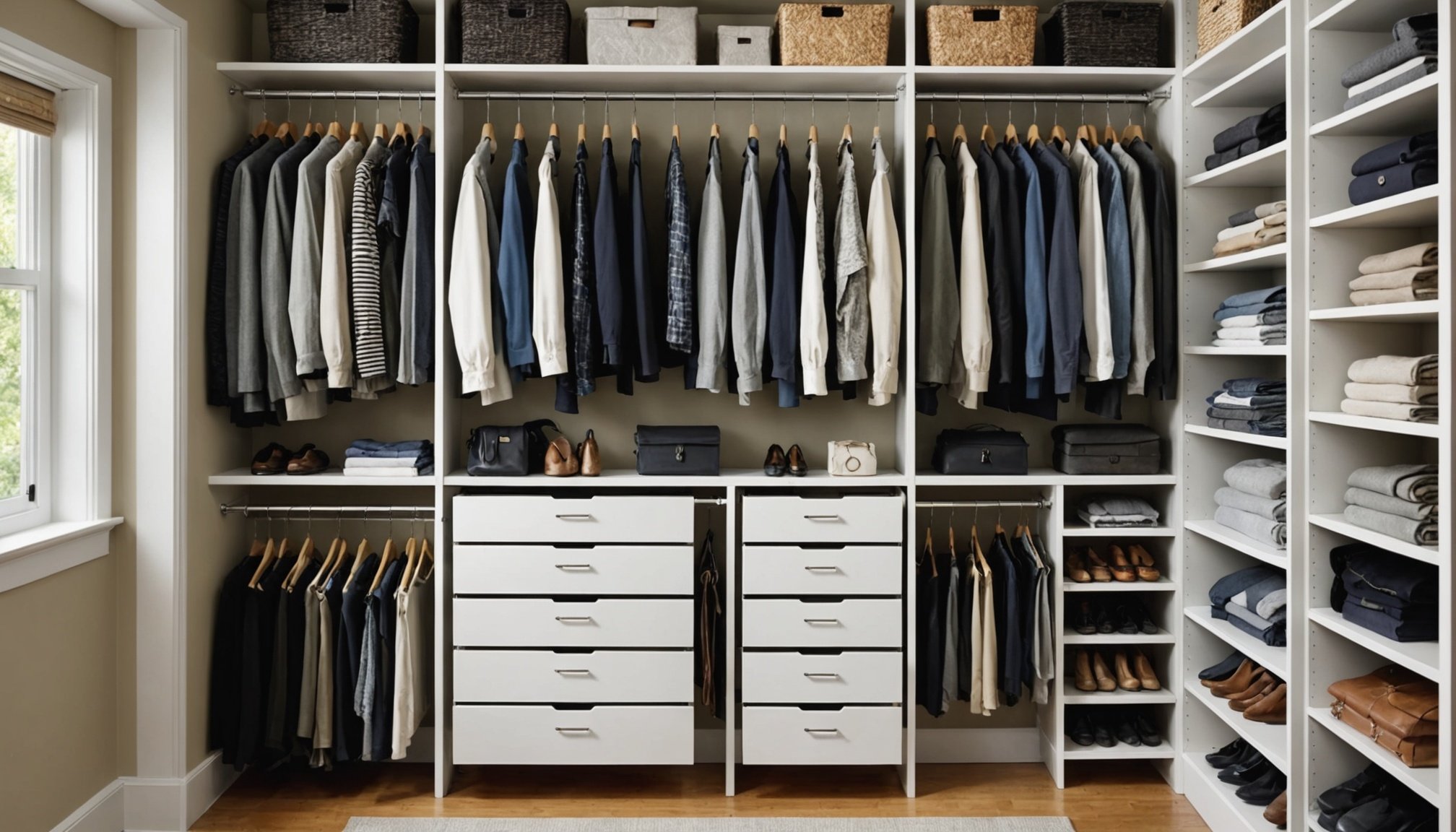Understanding the Challenges of Small Closet Storage
Facing storage limitations in a small closet can feel like a never-ending puzzle. Many individuals experience common challenges including insufficient space for their belongings and a lack of organizational structure, making daily routines more chaotic than necessary. These spaces often become overstuffed, leading to difficulty locating items when needed, which impacts daily efficiency.
A significant aspect of tackling these organization struggles lies in identifying personal needs and priorities for storage. An unorganized closet can be more than inconvenient; it can add stress, especially during busy mornings. By understanding the specific challenges and devising a plan to counteract them, you can transform the space into a functional storage haven rather than a chaotic jumble.
Also to read : Spring into style: your essential guide to the best eco-friendly bags for sustainable fashion
To optimise small closet usage, one might start by evaluating the types of items that need storing and how frequently they are accessed. Prioritizing by usage frequency helps in determining what should be easily accessible and what can be stored away. Maximizing every inch of the closet through innovative solutions and better organization can enhance both space capacity and efficiency. Remember, the perfect balance between space utilization and ease of access is key to maintaining a well-organized closet.
Essential Tools and Supplies for Effective Storage
To tackle the small closet challenges, the right closet organization tools and storage solutions are paramount. Must-have tools include sturdy hangers, tiered shelving, and space-efficient hanging storage options. These essentials help navigate storage limitations by maximizing every corner and cranny of the closet.
Also read : The definitive handbook to the most resilient fabrics for women”s activewear: unveiling enduring durability
Employing labels and clear storage bins can greatly enhance visibility and accessibility, saving you from rummaging through piles just to find that one missing sock. Clear bins display contents at a glance, making daily routines smoother and more efficient. Labels, on the other hand, ensure that everything has its proper place, significantly reducing clutter.
Prior to purchasing storage supplies, it is crucial to measure the available space. Accurate dimensions prevent the frustration of buying ill-fitted items and help you make the most of your space. Measuring enables you to choose appropriate solutions that fit seamlessly, rather than crowding the limited area.
Key points to remember: Always aim for tools that offer both function and versatility. When chosen wisely, they can transform storage struggles into a streamlined experience, optimizing even the smallest closet areas. This way, the daily hustle is minimized, and you gain a sense of order and tranquillity.
Utilizing Vertical Space Efficiently
Making the most of vertical space is key to overcoming storage limitations in small closets. Start by exploring various hanging solutions which are both innovative and convenient. Overhead rods, for instance, offer a fantastic method for optimizing height, allowing you to store off-season items up high while keeping frequently used clothing at reachable levels.
Incorporate hooks and racks as viable options for improving vertical storage. These can be easily attached to closet walls, providing additional places for hanging not only clothes but also accessories such as hats, scarves, and bags. This simple setup greatly enhances the organization and clears the floor space for larger items.
The often-overlooked closet doors hold potential for additional storage, too. Install racks or over-the-door organisers for shoes or smaller items, maximising every inch of your closet. Adjustable shelving within the closet provides flexibility, adapting to changing needs and preferences without hassle.
Prioritising wall-mounted cabinets can further increase storage potential without sacrificing floor space. By systematically utilising these strategies, small closet spaces can be transformed to accommodate more essentials while maintaining organization and accessibility. Implementing these innovative shelving solutions can alleviate storage headaches significantly.
Multi-Functional Furniture for Small Spaces
Multi-functional furniture is an innovative solution for overcoming small closet challenges by serving multiple purposes, thus addressing storage limitations effectively. These versatile pieces, such as ottomans with hidden compartments and beds with built-in drawers, enhance organization struggles by offering additional space without cluttering your room.
Consider incorporating dual-purpose items in your living space to maximise efficiency. For instance, a sofa bed provides seating during the day and a sleeping area at night, eliminating the need for a separate guest bed. Similarly, a fold-out desk can function as a workspace and quickly retract when not in use, personalizing your setup and maximizing your floor space.
Choosing the right multi-functional furniture requires attention to both practicality and aesthetics. Select pieces that not only fit your storage needs but also complement your room’s decor. Opt for sleek, modern designs or rustic, classic styles based on your taste.
Space-saving solutions help create a balanced environment, freeing up crucial room space while maintaining an orderly appearance. By investing in such dual-use furniture, you create a dynamic and adaptable home, facilitating convenient transitions between daily activities and ensuring ease of access to stored items.
DIY Projects for Custom Closet Storage
DIY closet solutions can transform cramped spaces into organized havens. By undertaking simple home projects, you can craft storage solutions that fit your specific needs. A notable advantage of these projects is their cost-effectiveness, allowing you to expand your storage without breaking the bank.
Budget-friendly tips include utilising stackable boxes or baskets, which you can easily label and arrange. Using tension rods, you can create extra hanging areas for accessories or lightweight items. Consider repurposing old furniture parts; an old ladder can serve as a perfect makeshift vertical hanger.
Creativity plays a pivotal role in crafting efficient custom storage solutions. Customised shelving using wooden crates or boxes not only enhances the closet’s capacity but also adds a touch of personality to your space. Installing pegboards on closet walls creates versatile backdrops for hooks and clips, perfect for hanging items that would otherwise clutter the floor.
Repurposing items introduces eco-friendly practices into your storage strategy. Old jars can become elegant holders for smaller items like scarves or hats, while decorative knobs attached to closet walls serve as unique hooks for bags and belts. These creative ways make the most of limited space while personalizing your closet with minimal expense.
Seasonal and Rotational Organization Strategies
Integrating seasonal storage strategies within your closet can drastically increase its efficiency. Start by identifying seasonal clothing items, which can be rotated to fit only the essentials. For instance, store winter coats during summer by utilising storage bins or vacuum-sealed bags, freeing up space for clothes you’ll wear immediately.
The practice of rotation techniques ensures that your closet adapts to changing seasonal requirements. As seasons transition, rotating clothes keeps only the relevant items accessible, reducing clutter and improving the overall organization. This approach offers a structured method to selecting wardrobe essentials while maintaining a cleaner appearance.
Regular decluttering is vital for effective maximizing of space. Set a schedule to evaluate your closet every few months, removing items that have not been used. Implementing systematic categorization, such as grouping items by type or function, aids accessibility and ensures efficiency.
Lastly, when organizing seasonal items, consider using top shelves or even under-bed storage solutions to minimize closet crowding. Clear storage boxes with labels help in quickly identifying contents and streamlining the rotation process, ensuring everything stays neat while seasonal needs change. Through these strategies, your small closet can become a manageable space, free from unnecessary overcrowding.
Visual Examples and Case Studies
For anyone tackling small closet challenges, seeing practical applications can be immensely helpful. Reviewing closet examples and success stories provides not only inspiration but also actionable solutions to common storage limitations.
One such example is a before-and-after story where a closet, once cluttered with unorganised garments, transformed into a structured haven through innovative methods. By incorporating shelving ideas and vertical storage solutions, the owner maximised efficiency. Instead of traditional, fixed shelves, they opted for adjustable shelving, enabling flexible configuration based on seasonal needs.
Success stories often highlight how prioritizing needs and adopting a systematic approach can make a significant difference. A case study might detail how using labelled, clear storage bins enhanced accessibility and visibility, leading to smoother daily routines. Overhead hanging solutions provided additional height optimisation, allowing for extensive use of every available inch.
When it comes to understanding these transformations, visuals play a crucial role. Images of organised spaces capture how strategic placement and thoughtful design can improve both aesthetics and function. Observing these visual organization ideas helps translate abstract strategies into feasible actions, encouraging individuals to replicate successful methods in their own closets.
Seasonal and Rotational Organization Strategies
Incorporating seasonal storage solutions is essential for managing small closet spaces effectively. Start by categorising your wardrobe into seasonal groups. During warmer months, bulky winter apparel, like coats and boots, can be stored in vacuum-sealed bags or clear bins, reducing clutter and freeing up valuable space for summer essentials.
Employing rotation techniques ensures that only relevant clothing remains accessible, thereby enhancing organization and streamlining daily routines. As seasons change, rotate items seamlessly, maintaining a functional, well-organized closet year-round.
Regular decluttering sessions are crucial to avoid overwhelming your space. Schedule times to assess the necessity of each piece, donating or storing unused items. This practice not only maximizes space but also simplifies the rotation process.
To organise seasonal items optimally, use top shelves or under-bed storage solutions to keep less-used clothing out of the way. Label each storage bin clearly to easily identify contents during transitions between seasons. Systematic categorization by type or frequency of use further contributes to a neat and efficient closet.
By implementing these seasonal storage strategies, you maintain order, making your small closet space manageable and efficient without overcrowding, allowing for a fluid transition between seasons.











